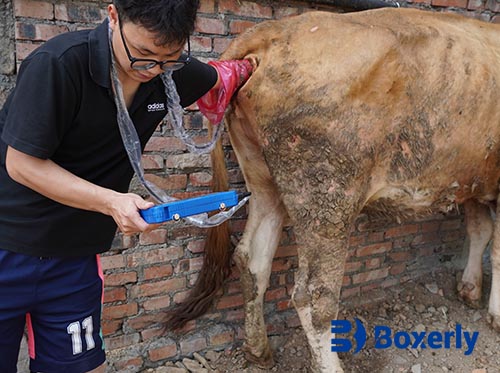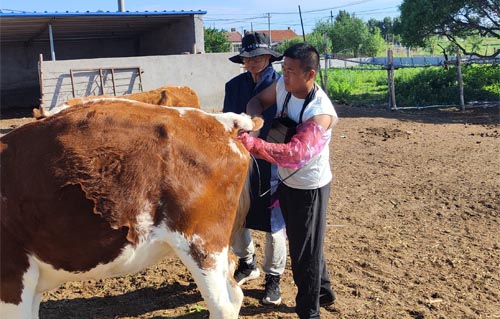In modern cattle farming, reproductive efficiency is a cornerstone of productivity. Whether in beef or dairy herds, accelerating reproduction not only increases herd numbers but also enhances genetic quality and overall profitability. As the global livestock industry continues to evolve, veterinary ultrasonography—commonly referred to as veterinary ultrasound—has become one of the most powerful, non-invasive tools for managing every stage of cattle reproduction. From assessing the onset of puberty to confirming pregnancy and monitoring fetal development, ultrasound offers real-time insights that were once unimaginable in the field.

In this article, we explore the pivotal role veterinary ultrasound plays in reproductive management of cattle, integrating international understanding and best practices.
Understanding Bovine Reproductive Physiology
To appreciate how ultrasound fits into reproductive management, we must first understand the natural progression of bovine reproductive development—especially in heifers (young female cattle).
After birth, a heifer’s reproductive organs begin developing alongside other body systems. As the animal matures, the hypothalamus starts to secrete gonadotropin-releasing hormone (GnRH), which stimulates the anterior pituitary gland to release follicle-stimulating hormone (FSH) and luteinizing hormone (LH). These hormones trigger the growth of ovarian follicles and the production of estrogen and progesterone, leading to sexual maturity and the onset of estrus (heat). This initial period of heat marks the beginning of the heifer’s sexual maturity, known as puberty.
Puberty onset varies across breeds and environmental conditions. For example:
-
Holstein-Friesian dairy heifers typically reach puberty between 6–13 months of age.
-
In southern China, local yellow cattle may mature earlier due to warmer climate conditions.
-
Water buffalo heifers often mature later, around 24–30 months.
However, sexual maturity does not automatically mean readiness for breeding. Full physical maturity—when skeletal, muscular, and internal organ systems are fully developed—occurs later. For instance, Holstein heifers generally reach full body maturity between 15–18 months. Breeding too early can result in complications, so understanding both sexual and physical maturity is essential for successful reproduction.

Veterinary Ultrasound in Estrus Detection
Detecting estrus accurately is crucial for timing artificial insemination (AI) or natural breeding. In traditional management, farmers relied on behavioral cues such as restlessness, mounting, and vulvar discharge. However, these signs can be subtle or missed altogether in confined or large-scale systems.
Veterinary ultrasound changes the game by allowing direct visualization of ovarian structures. Using a transrectal probe, veterinarians or trained technicians can monitor follicular development in real-time. This enables precise identification of the optimal breeding window:
-
Dominant follicles, usually 12–20 mm in diameter, signal imminent ovulation.
-
Absence of follicles or presence of corpus luteum (CL) suggests the cow is not in heat.
This kind of precision reduces failed insemination attempts, improves conception rates, and ultimately shortens the calving interval.
Pregnancy Diagnosis Using Veterinary Ultrasound
Perhaps the most well-known use of ultrasound in cattle is pregnancy diagnosis. While rectal palpation has been a traditional method for decades, ultrasound offers distinct advantages:
-
Early detection: Pregnancy can be confirmed as early as 26–30 days post-insemination.
-
Fetal viability: A beating fetal heart can be seen, helping identify live vs. non-viable embryos.
-
Twin detection: Ultrasound can confirm multiple embryos early, allowing tailored management.
-
Gender prediction: With experience and the right equipment, fetal sex can be identified after 55–60 days.
Early and accurate pregnancy diagnosis helps producers make informed decisions about nutrition, housing, and rebreeding, improving overall herd efficiency.

Ultrasound Monitoring of Fetal and Uterine Health
Beyond diagnosis, ultrasound helps monitor the ongoing health of the pregnancy:
-
Placental health: Any abnormalities like placentitis can be detected and treated early.
-
Uterine involution: Postpartum, ultrasound confirms whether the uterus has returned to its non-pregnant state, which is essential before rebreeding.
In high-producing dairy cows, timely uterine recovery is vital for maintaining short calving intervals and reducing economic losses.
Prepartum and Postpartum Care with Ultrasound
In the final weeks before calving, ultrasound can assess fetal position, size, and movement, which helps anticipate complications during labor. In cases of suspected dystocia (difficult calving), veterinarians can assess whether the calf is properly aligned and if intervention is needed.
Postpartum, retained placentas, endometritis, and delayed uterine involution can all be diagnosed via ultrasound, allowing for timely treatment and reduced risk of fertility loss.
Applications in Bull Fertility Assessment
Veterinary ultrasound is not limited to females. Evaluating bull fertility is another area where it shines:
-
Testicular ultrasonography can assess testis size, structure, and symmetry.
-
It helps identify abnormalities such as fibrosis, inflammation, or tumors.
-
In breeding soundness exams, ultrasound complements semen analysis to ensure bulls are fertile before breeding season.
This is especially important in seasonal or extensive grazing systems where every breeding opportunity counts.
Benefits of Veterinary Ultrasound in Reproductive Programs
Internationally, producers and veterinarians recognize several key benefits of using ultrasound in reproductive programs:
-
Non-invasive and repeatable: Unlike surgical or invasive diagnostics, ultrasound can be safely used multiple times without causing animal stress.
-
Real-time visualization: Results are immediate, allowing for on-the-spot decisions.
-
Cost-effective: When integrated into routine management, ultrasound reduces reproductive losses and increases calving rates, quickly offsetting equipment and training costs.
-
Enhanced herd genetics: By identifying and managing fertile animals more effectively, herds can be improved genetically with better replacements and productive longevity.
-
Environmental sustainability: Improved reproductive efficiency means fewer resources (feed, water, land) are needed per calf produced.

International Perspectives and Adoption
In countries like the United States, Canada, Australia, and parts of Europe, veterinary ultrasound has been integrated into herd health programs for decades. Universities and veterinary colleges now include ultrasonography as a core competency, and training is available to both vets and farmers.
In developing regions, adoption is growing as portable ultrasound devices become more affordable. Solar-powered and rugged models are now available for field use, enabling even remote operations to benefit from the technology.
Challenges and Training Requirements
Despite its advantages, ultrasound use requires skill and experience. Misinterpretation of images can lead to poor decisions. Therefore, training programs—both formal and on-farm—are crucial. In some regions, lack of access to training is a barrier to adoption.
Additionally, cost may still be a concern for smallholder farmers, though shared equipment models or veterinary cooperatives can help lower the threshold.
Conclusion
Veterinary ultrasound has revolutionized cattle reproduction management. By providing accurate, early, and non-invasive insights into reproductive status, it empowers producers to make better decisions that enhance productivity, profitability, and animal welfare. As global understanding of reproductive physiology deepens and technology becomes more accessible, ultrasound will continue to play a critical role in advancing the cattle industry worldwide.
For both seasoned professionals and emerging farmers, mastering this tool is not just a technical skill—it’s a gateway to more efficient, ethical, and sustainable livestock farming.
References
-
Fricke, P. M. (2002). Scanning the future—ultrasonography as a reproductive management tool for dairy cattle. Journal of Dairy Science, 85(8), 1918-1926.
-
Pursley, J. R., & Silvia, W. J. (2007). Reproductive management of cows using synchronization and ultrasound. Veterinary Clinics: Food Animal Practice.
-
DairyNZ. (2023). Reproductive management with ultrasound. https://www.dairynz.co.nz